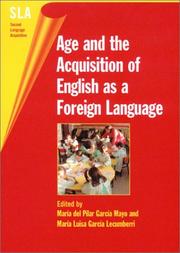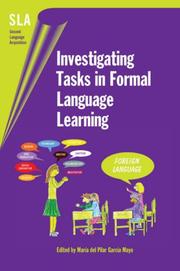| Listing 1 - 9 of 9 |
Sort by
|
Book
ISBN: 9781501511318 1501511319 1501511246 Year: 2021 Publisher: Berlin Boston
Abstract | Keywords | Export | Availability | Bookmark
 Loading...
Loading...Choose an application
- Reference Manager
- EndNote
- RefWorks (Direct export to RefWorks)
Since the introduction of communicative language teaching, collaborative learning has played an important role in the second language (L2) classroom. Drawing from sociocultural theory, which states that human cognitive development is a socially situated activity mediated by language, studies in L2 pedagogy advocate the use of tasks that require learners to work together. Collaborative dialogue encourages language learning, and research shows that the solutions reached by students in this process are more often correct with a lasting influence on their language comprehension. This volume includes ten chapters that illustrate the benefits of collaborative dialogue in second foreign language classrooms. The volume considers key issues dealing with collaborative tasks and implications for language teaching.
Dialogue --- Foreign language acquisition --- Collaboration --- Dialog --- Drama
Book
ISBN: 1783098120 1783098112 9781783098125 Year: 2017 Publisher: Blue Ridge Summit, PA : Multilingual Matters,
Abstract | Keywords | Export | Availability | Bookmark
 Loading...
Loading...Choose an application
- Reference Manager
- EndNote
- RefWorks (Direct export to RefWorks)
This book presents research on the learning of foreign languages by children aged 6-12 years old in primary school settings. The collection provides a significant and important contribution to this often overlooked domain and aims to provide research-based evidence that might help to inform and develop pedagogical practice. Topics covered in the chapters include the influence of learner characteristics on word retrieval; explicit second language learning and language awareness; meaning construction; narrative oral development; conversational interaction and how it relates to individual variables; first language use; feedback on written production; intercultural awareness raising and feedback on diagnostic assessment. It will be of interest to undergraduate and graduate students, researchers, teachers and stakeholders who are interested in research on how children learn a second language at primary school.
English language --- Language and languages --- Language acquisition --- Bilingualism in children. --- Study and teaching (Primary) --- Foreign speakers. --- Age factors. --- L1. --- SLA. --- child SLA. --- child foreign language learning. --- children. --- early language learning. --- foreign language acquisition. --- foreign language learning. --- foreign languages. --- implicit/explicit learning. --- interaction. --- metalinguistic awareness. --- primary school. --- second language acquisition. --- teaching languages to young children . --- young language learners.
Book
ISBN: 9789027253101 9789027289117 9027289115 9027253102 1282245325 9781282245327 9786612245329 6612245328 Year: 2009 Publisher: Amsterdam Philadelphia John Benjamins Pub. Co.
Abstract | Keywords | Export | Availability | Bookmark
 Loading...
Loading...Choose an application
- Reference Manager
- EndNote
- RefWorks (Direct export to RefWorks)
The studies in this collection address a topic that has recently become the focus of considerable interest in second language acquisition (SLA) research: the acquisition of articles. Languages appear to vary in whether they have articles (English, German, Norwegian do, but Chinese, Japanese, Russian do not). Languages that have articles also appear to divide into those that realise definiteness (e.g. English) and those that realise specificity (e.g. Samoan). When speakers of one type of language learn an L2 of a different type, issues of central concern to SLA research arise: the nature of L1 influence, the time course of development, ultimate attainment, the relationship between performance and competence, and the role of Universal Grammar. These issues are considered in nine studies, written by researchers whose work is at the forefront of enquiry, that offer new data, new perspectives and new insights into the way L2 speakers acquire articles.
Grammar, Comparative and general --- Second language acquisition. --- Article. --- Article --- Second language learning --- Language acquisition --- Function words --- Linguistics --- Philology
Book
ISBN: 9781501511479 9781501519383 9781501503399 1501503294 1501503391 9781501503290 1501511475 1501511475 9781501503405 Year: 2018 Volume: 27 Publisher: Boston
Abstract | Keywords | Export | Availability | Bookmark
 Loading...
Loading...Choose an application
- Reference Manager
- EndNote
- RefWorks (Direct export to RefWorks)
The last three decades have witnessed a growth of interest in research on tasks from various perspectives and numerous books and collections of articles have been published focusing on the notion of task and its utility in different contexts. Nevertheless, what is lacking is a multi-faceted examination of tasks from different important perspectives. This edited volume, with four sections of three chapters each, views tasks and Task-based Language Teaching (TBLT) from four distinct (but complementary) vantage points. In the first section, all chapters view tasks from a cognitive-interactionist angle with each addressing one key facet of either cognition or interaction (or both) in different contexts (CALL and EFL/ESL). Section two hinges on the idea that language teaching and learning is perhaps best conceptualized, understood, and investigated within a complexity theory framework which accounts for the dynamicity and interrelatedness of the variables involved. Viewing TBLT from a sociocultural lens is what connects the chapters included in the third section. Finally, the fourth section views TBLT from pedagogical and curricular vantage points.
Language and languages --- Task analysis in education --- Cognitive learning --- Learning --- Analysis, Task (Education) --- Education --- Foreign language study --- Language and education --- Language schools --- Study and teaching --- E-books --- Task analysis in education. --- Cognitive learning. --- Study and teaching. --- Language and languages Study and teaching --- TBLT. --- Task-Based Learning and Teaching. --- Tasks and Cognition. --- Tasks and Complexity Theory. --- Tasks and Pedagogy. --- Tasks and Sociocultural Theory.


ISBN: 1788920384 128082817X 9786610828173 9781853596403 185359640X 9781853596407 1853596396 9781853596391 1853596388 1853596396 9781853596391 9781853596384 9781788920384 Year: 2003 Volume: 4. Publisher: Bristol Blue Ridge Summit
Abstract | Keywords | Export | Availability | Bookmark
 Loading...
Loading...Choose an application
- Reference Manager
- EndNote
- RefWorks (Direct export to RefWorks)
This book provides an overview of current research on the age factor in foreign language learning, addressing issues, which are critical for language planning. It presents new research on foreign language learning within bilingual communities in formal instruction settings focussing on syntax, phonology, writing, oral skills and learning strategies.
Bilingualism in children. --- English language --- Language acquisition --- Language and languages --- Foreign language study --- Language and education --- Language schools --- Age factors in language acquisition --- Ability, Influence of age on --- EFL (Language study) --- English as a foreign language --- English as a second language --- English to speakers of other languages --- ESL (Language study) --- ESOL (Language study) --- Teaching English as a second language --- TEFL (Language study) --- TESL (Language study) --- Children --- Study and teaching --- Foreign speakers. --- Age factors. --- Study and teaching. --- Foreign students --- Langage --- Langage et langues --- Anglais (Langue) --- Bilinguisme chez l'enfant --- Acquisition --- Facteurs liés à l'âge --- Etude et enseignement --- Allophones --- Language and languages Study and teaching --- Interpersonal communication in children --- Psycholinguistics --- Germanic languages --- age and SLA. --- age and foreign language learning. --- age factor in SLA. --- age factor. --- age in second language acquisition. --- language learning. --- second language acquisition.


ISBN: 1853599263 1853599271 9781853599279 9781853599262 185359928X 9781853599286 1280739428 9786610739424 1788920368 9781280739422 6610739420 9781788920360 Year: 2006 Publisher: Bristol Blue Ridge Summit
Abstract | Keywords | Export | Availability | Bookmark
 Loading...
Loading...Choose an application
- Reference Manager
- EndNote
- RefWorks (Direct export to RefWorks)
This book contributes to the growth of interest in task-based language learning and teaching that has been seen in recent years. It brings together research that focuses on various aspects and effects of pedagogic task design and presents work that uses tasks to examine oral interaction, written production, vocabulary and reading, lexical innovation and pragmatics in different formal language learning contexts and in different languages (English as a second/foreign language, French/German/Italian/Spanish as foreign languages). It also provides guidelines for task classification, sequencing and design. The book is addressed to both professionals and students interested in second language acquisition research. It will also be of use to professionals involved in language pedagogy and curriculum design.
Language and languages --- Task analysis in education. --- Study and teaching. --- Analysis, Task (Education) --- Foreign language study --- Education --- Language and education --- Language schools --- Language and languages Study and teaching --- Study and teaching --- SLA. --- Second Language Acquisition. --- classroom. --- curriculum design. --- formal language learning contexts. --- language pedagogy. --- task-based language learning. --- task-based language teaching. --- vocabulary.
Book

ISBN: 9781783098323 Year: 2017 Publisher: Bristol Blue Ridge Summit
Abstract | Keywords | Export | Availability | Bookmark
 Loading...
Loading...Choose an application
- Reference Manager
- EndNote
- RefWorks (Direct export to RefWorks)
This is the first collection of research studies to explore the potential for mixed methods to shed light on foreign or second language learning by young learners in instructed contexts. It brings together recent studies undertaken in Cameroon, China, Croatia, Ethiopia, France, Germany, Italy, Kenya, Mexico, Slovenia, Spain, Sweden, Tanzania and the UK. Themes include English as an additional language, English as a second or foreign language, French as a modern foreign language, medium of instruction controversies and content and language integrated learning (CLIL). The volume reviews the choice of research methodologies for early language learning research in schools with a particular focus on mixed methods and proposes that in the multidisciplinary context of early language learning this paradigm allows for a more comprehensive understanding of the evidence than other approaches might provide. The collection will be of interest to in-service and trainee teachers of young language learners, graduate students in the field of TESOL and early language learning, teacher educators, researchers and policymakers.
Language acquisition --- Language and languages --- CLIL. --- Early language learning. --- English as a foreign language. --- English as a second language. --- English. --- SLA. --- TESOL. --- bilingualism. --- complexity research. --- language acquisition. --- mixed methods. --- second language acquisition. --- young learners. --- LANGUAGE ARTS & DISCIPLINES / Study & Teaching. --- Foreign languages --- Languages --- Anthropology --- Communication --- Ethnology --- Information theory --- Meaning (Psychology) --- Philology --- Linguistics --- Interpersonal communication in children --- Psycholinguistics --- Age factors --- Age factors. --- Foreign countries. --- Study and teaching (Elementary) --- Study and teaching (Primary)
Book

ISBN: 9781788929462 9781788929479 1788929470 1788929454 9781788929455 1788929462 Year: 2020 Publisher: Bristol Blue Ridge Summit
Abstract | Keywords | Export | Availability | Bookmark
 Loading...
Loading...Choose an application
- Reference Manager
- EndNote
- RefWorks (Direct export to RefWorks)
This book examines the use of tasks in second language instruction in a variety of international contexts, and addresses the need for a better understanding of how tasks are used in teaching and program-level decision-making. The chapters consider the benefits and challenges that teachers, program designers and researchers face in using tasks.
Book

ISBN: 9781783098118 Year: 2017 Publisher: Bristol Blue Ridge Summit
Abstract | Keywords | Export | Availability | Bookmark
 Loading...
Loading...Choose an application
- Reference Manager
- EndNote
- RefWorks (Direct export to RefWorks)
| Listing 1 - 9 of 9 |
Sort by
|

 Search
Search Feedback
Feedback About UniCat
About UniCat  Help
Help News
News